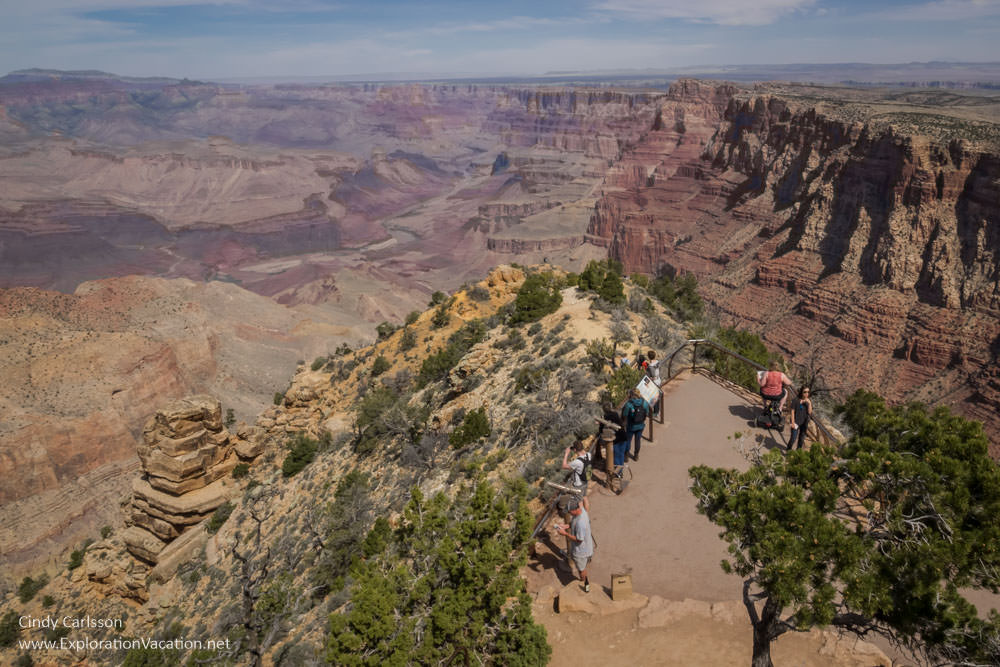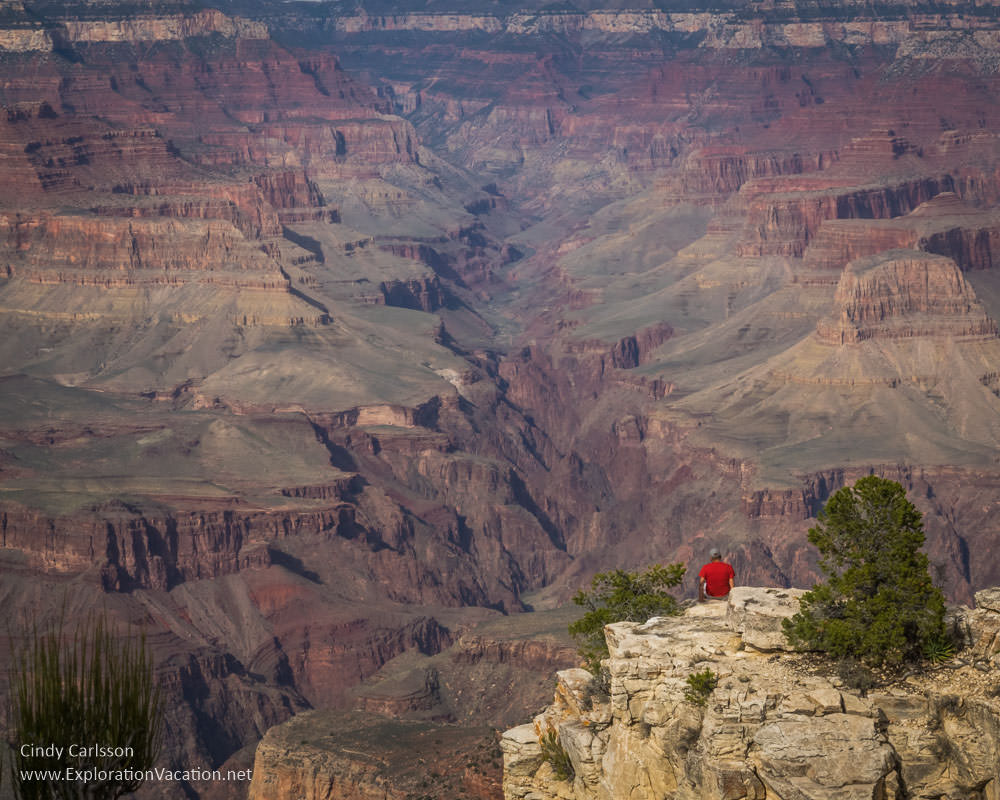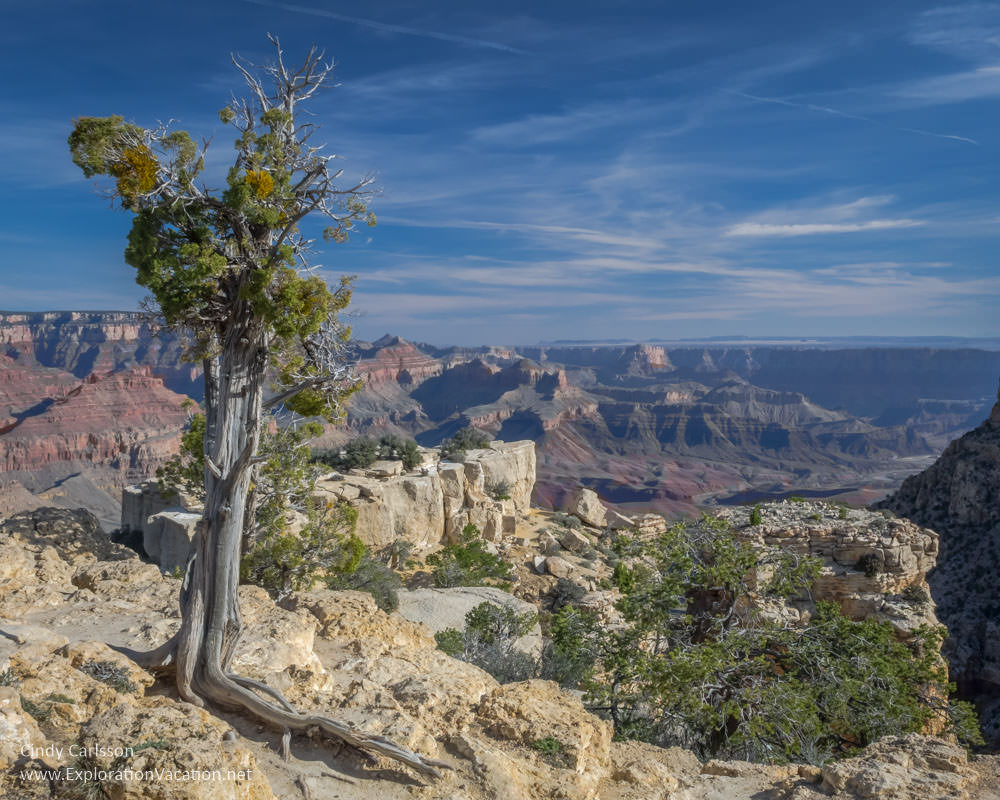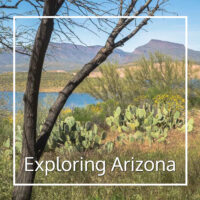Last updated on April 11th, 2024
Grand Canyon National Park includes both the canyon’s popular South Rim and the far more remote and less-visited North Rim. Both are part of the Grand Canyon National Park UNESCO World Heritage site. And both are worth far more time than most visitors give them!
Here’s what you need to know to plan a visit that gives you time to really absorb the immensity of this incredible landscape.
(I originally published this post on the Grand Canyon for World Heritage Sites.net, a website that provides information specifically for travelers interested in World Heritage sites.)

Visitors admire the Grand Canyon from the Desert View overlook on the South Rim.
This post contains links. Some links may pay me a small commission if you use them to reserve a room, rent a car, or purchase goods or services. ou don’t pay extra, but it helps keep this website running without intrusive advertisements. To learn more, review my policies and disclosures.
What is Grand Canyon National Park?
Grand Canyon National Park features one of the world’s largest and most dramatic gorges. The twisting canyon of the Colorado River is both a stunning landscape and a 1.5 km (almost a mile) deep map of earth’s geological evolution.

You’ll find plenty of places to enjoy views of the canyon from overlooks and marked trails right along the rim on either side of the Grand Canyon.
The park covers nearly 5,000 sq km (almost 2,000 sq miles) in the canyon and along the rim above. Hikers and river rafters can explore the bottom of the canyon, but most visitors only see it from the rim above. There they find stunning views over a vast landscape of mountains and buttes that seem to rise endlessly from the valley below.
Why is Grand Canyon National Park a UNESCO World Heritage site?
Grand Canyon National Park is a UNESCO World Heritage site because of its size, beauty, geology, ecosystems, fossils, and more.
UNESCO explains: “Its vastness is stunning, and the evidence it reveals about the earth’s history is invaluable. . . . The buttes, spires, mesas and temples in the canyon are in fact mountains looked down upon from the rims. Horizontal strata exposed in the canyon retrace geological history over 2 billion years and represent the four major geologic eras.”

View of the North Rim from the Cape Royal Overlook.
What can you expect on a visit to the Grand Canyon?
The national park has two developed areas on the North and South Rims. Both provide similar views of and access to the canyon itself. Both also offer a range of hiking trails, paved paths, and overlooks, as well as food and lodging. A combination of roads and trails in each area make it easy to take in the astounding scenery. Paths wind along the rim and below. Scenic lookouts take visitors right to the very edge of the gorge. In addition, mule rides and access to facilities at the bottom of the canyon are also available on both sides of the canyon.
The biggest difference between the two visitor areas? The South Rim is much more developed and gets many more visitors.

The Desert View Watchtower is one of many buildings in the park that is also on the National Register of Historic Places.
What to expect when visiting the South Rim
But the South Rim is actually what most people think of as the Grand Canyon. With lots of dining and lodging options, historic buildings, a couple small museums, and easy access from Phoenix, this is by far the most popular part of the park. It can be very crowded, but it is still stunning.
And there are lots of options for how you spend your time here. Take a day hike along or just below the rim or (if you are very fit) spend couple of days hiking to the bottom of the canyon and back up. Or enjoy sunrise over the canyon, take a short hike along the rim, and then sit down for a gourmet lunch in a restaurant at the canyon’s edge! While there is plenty of nature to explore along the South Rim, there are plenty of other things to do too. That makes it suitable for both serious hiking or a fun family vacation.
(Want to see the view from all the South Rim scenic overlooks? They are shown here.)
30-miles of road along the Grand Canyon’s South Rim provide easy access to spectacular scenery!
What to expect when visiting the North Rim
On the other hand, only about 10% of visitors see the Grand Canyon from the North Rim. That means they get the same spectacular views (or maybe even better ones) and it’s never very crowded. But there are fewer facilities here too. It feels more like being at the edge of a vast wilderness – and the canyon really is the focus.
Of course, you can always sit on the patio outside the lodge with a cocktail and watch the sunset. It’s not like you are really in the wilderness. But you can easily see if from here even if you don’t hike down into the canyon.

View from the Walhalla Overlook on the North Rim.
Is the Grand Canyon worth visiting?
The Grand Canyon is one of the great natural sights in the world. If you travel anywhere in the American Southwest, it should be on your itinerary.
Stay at the South Rim for a few hours, a few days, or more
Even if nature isn’t really your thing, you’re sure to be impressed by the vista from almost any overlook. The South Rim also has interesting historic buildings, a couple of small museums, and a few other cultural options and a wide variety of outdoor activities for visitors of all ages and abilities.
Many people visit the South Rim as a day trip from Phoenix or even Las Vegas. This makes for a very long day and doesn’t leave a lot of time to explore the park. But if you just want to see the canyon and take a few pictures, it’s one way to do it. Just keep in mind that you will be in the park at the busiest time of day when simply getting in and finding a place to park can be a very slow process.

The view from the South Rim at Moran Point.
Staying overnight in the park or in a nearby city makes it easier to arrive earlier in the day when the park is less crowded. And it makes it much easier to enjoy the park at both sunrise and sunset, which are two of the most beautiful times of day here. But stay for a few days if you plan to hike, do a mule ride into the canyon, or just relax awhile in a stunning place.
On the South Rim you can find lodging of all types – both inside the national park and just outside the entrance in Tusayan. If you want to stay right in the national park, be sure to book lodging in Grand Canyon Village.
See the National Park Service’s Grand Canyon lodging page for more information about what’s available within the park and how to book directly.
- Review and book El Tovar, the South Rim’s historic grand hotel: Tripadvisor, Expedia, or Hotels.com.
- All hotels in the park are available through Expedia and Hotels.com. (Just watch that your search doesn’t take you out of Grand Canyon Village.)
- Lodging at Phantom Ranch at the bottom of the Grand Canyon is available only through an on-line lottery.
For lodging in Tusayan, check Tripadvisor (a great list of what’s in the area, but a very limited number of places can be booked through the site), Expedia, or Booking.com.
Stay at the North Rim for at least a few days
Because of its relative inaccessibility, the North Rim of the Grand Canyon isn’t a day trip destination. This is the place to rent a campsite or a cabin and settle in for a few days or a week or more. The park has a restaurant and offers mule tours, but lacks many of the other amenities of the South Rim. That makes the North Rim ideal for people who are happy to explore a stunning natural area without other diversions to keep them entertained.
Within the park, the Grand Canyon Lodge offers both cabins and motel rooms booked directly through the lodge. Camping is also available at the North Rim Campground. Because of the longer travel time needed to get into the park, visitors are advised to spend at least one night in the park.
If you can’t get lodging within the park, the nearest options are generally 70-90 miles away around Fredonia, Arizona, and Kanab, Utah. Check Tripadvisor, Expedia, Hotels.com, and Booking.com for options and keep in mind that actual travel times are likely longer than you are anticipating.
Vrbo has a number of options around Fredonia and beyond.
A few campgrounds are available closer to the park entrance.
Tips for visiting the Grand Canyon World Heritage Site
The South Rim is open year-round, except when winter weather causes a temporary road closure. On the other hand, most facilities on the North Rim are only open during the summer season. There is no road access to the North Rim in winter. However, winter camping is available for part of the winter for those who hike, snowshoe, or cross-country ski into the park.
Plan ahead. Lodging is available on both the North and South Rim, but book well in advance. And, while lodging options abound near the park on the South Rim, there are no nearby options on the North Rim. And trips down to Phantom Ranch at the bottom of the canyon (from either side) require reservations very, very far in advance.
Even if you don’t plan to hike very far, carry plenty of water at all times. It’s easy to follow a trail just a little farther than you planned. Hiking down into the canyon even a little way is going to involve a strenuous hike back out. And the air is usually very dry.
Be prepared for very cold weather any time between November and March and for extremely hot weather during the summer.
Open-toe shoes are fine if you stay on the paved walkways. But wear sturdy shoes if you are walking anywhere else, as many paths and trails are dusty, uneven, rocky, and often lined with pricky vegetation. And some paths are shared with mules.
Morning is the quietest time anywhere in the park and sunrises can be absolutely spectacular.
Some roads along the South Rim are closed to private vehicles most of the year. Allow extra time to get around if you are using the shuttle. When the park is busy you may need to wait for more than one shuttle before it’s your turn to board.
Activities in Grand Canyon National Park
Hiking in Grand Canyon can range from a stroll from the edge of a parking area to a scenic overlook to a multi-day hike down into the canyon — and everything in between. Just be very aware of your own limitations and keep in mind that this is a very harsh environment.
Part of the drive along the South Rim is closed to vehicles most of the year, making it ideal for biking. But bicycling is a great way to travel along much of the South Rim.
Mule trips take visitors either part way into the canyon or (from the South Rim) all the way down to Phantom Ranch. (Book well in advance if you want to ride a mule down from the South Rim.)

Taking a break on the way down into the Grand Canyon.
River rafting trips offer an opportunity to see the canyon from below. You can book a multi-day rafting trip that runs through the World Heritage Site. The National Park Service has a list of companies authorized to offer a wide variety of trips on the Colorado River.
And then there are helicopter and other sightseeing flights over the Grand Canyon. Some of these go over the National Park. These offer spectacular views over the park at the cost of air and noise pollution in this wilderness area. If you decide you need to do this, you can book directly through any number of companies or through Viator and GetYourGuide. (As a responsible traveller it’s better to book directly with the company providing the tour, but third-party services may be the best option if you need transportation or other services to make a tour work for you. And they make it easy to search for options.)
Other things to do in the area
The UNESCO site only includes the national park, which winds around most of the canyon. But the Hualapai Tribe has an area where they offer a variety of activities. Called the West Canyon, this is where you’ll find the Grand Canyon Skywalk, a zipline, and other tourist infrastructure that takes you in and above the canyon.
Havasu Falls is located in a remote spot between the developed South Rim area of the national park and Grand Canyon west. This is a strenuous multi-day hike.
A visit to the North Rim combines well with Zion and/or Bryce National Parks.
Where is the Grand Canyon?
Grand Canyon National Park is located in northern Arizona.
South Rim entrance
The South Rim has two entrances: the South Entrance outside the town of Tusayan and the East Entrance near the park’s Desert Watchtower.
Driving to the South Rim
Most visitors enter at the South Entrance. Driving distances are:
- 130 km (80 miles) from Flagstaff
- 185 km (115 miles) from Sedona
- 370 km (230 miles) from Phoenix
- 450 km (280 miles) from Las Vegas.
Visitors coming from Lake Powell or Page will use the East Entrance (180 km/110 miles).
Driving times can be much longer than expected, as most routes include mountain roads.
Parking is included in your vehicle entry fee, but can be hard to find when it’s busy.
Flying to the South Rim
Phoenix and Flagstaff both have commercial air service. Limited air service is also available at the Grand Canyon Airport near the park. Sightseeing flights over the Grand Canyon leave from this airport.
Rail service to the South Rim
Fans of historic trains fans can take the Grand Canyon Railway to the park from the nearby city of Williams.
Amtrak offers rail service to Flagstaff that includes a bus connection to the park.
Shuttles and tours
Groome Transportation offers daily service to the South Rim from Phoenix and Flagstaff. Additional shuttle services may be available through area hotels as well.
Tours booked in Flagstaff, Phoenix, Las Vegas, or elsewhere will include transport to the park. However, tours from Las Vegas generally only visit the western end of the Grand Canyon, not the Grand Canyon World Heritage Site. And you really should spend more than a couple of hours at the Grand Canyon!
Rim to Rim
From the South Rim, the North Rim is an extremely strenuous 30 km (20 mile) two-day hike through the canyon or a 340 km (210 mile) drive.
A seasonal Trans-Canyon Shuttle also connects the two once a day in each direction. Travel time on the shuttle is about 4½ hours each way.
North Rim entrance
Grand Canyon National Park’s North Rim Entrance is located near the Utah border 50 km (30 miles) from Jacob Lake, Arizona.
Driving to the North Rim
Driving distances to the North Rim entrance are:
- 565 km (350 miles) from Phoenix
- 330 km (217 miles from Flagstaff
- 440 km (275 miles) from Las Vegas.
The Grand Canyon World Heritage site is a 180 km (110 mile) drive from Zion National Park, that will take at least two or three hours depending on the route. The drive from Bryce is 250 km (155 miles), with the same one-hour difference depending on the route you choose.
Once you enter the park, it’s still another 25 km (15 miles) to the rim itself.
Parking is included in your vehicle entry fee.
Aside from the Trans-Canyon Shuttle, there is no transit service to the North Rim.
For more information about this World Heritage Site
For more information about Grand Canyon National Park, its opening hours, admission fees, and park closures, see its official website.
Interested in learning about more UNESCO sites? Head over to WorldHeritageSites.net to find travel information for hundreds of fascinating World Heritage Sites.




